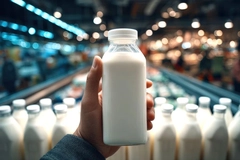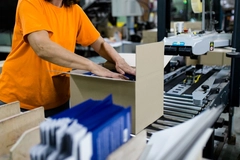“Renewable rebellion” in 2024? Experts weigh in on the year’s biggest promises and expectations

03 Jan 2024 --- Renewable resources were a focal point of the global packaging economy in 2023 — a trend set to continue gathering momentum this year. One definition of “renewability” is when a material can naturally be replenished faster than consumed.
Converting to fiber-based materials, increasing the use of metals and incorporating bio-based polymers into plastics are some of the key tactics packaging designers use to reduce their environmental footprints and stay ahead of legislative and consumer curves.
However, advanced recycling methods like pyrolysis could offer a means of synthetically replenishing materials (including plastics) faster than consumed. With these technological advancements, major shifts in the practice and definition of renewable packaging are on the horizon.
Packaging Insights speaks to experts from ATS-Tanner, Aimplas, PulPac and packaging analyst Neil Farmer about how the renewables market will impact packaging in 2024.
 PulPac’s team creating Dry Molded Fiber Technology.Linus Larsson Green, CEO of Swedish packaging group PulPac, says the most important development in renewable materials “is perhaps not only the actual materials themselves but how the larger circular economy can maximize utility and value from material feedstock and evaluate efficiency from the production processes.”
PulPac’s team creating Dry Molded Fiber Technology.Linus Larsson Green, CEO of Swedish packaging group PulPac, says the most important development in renewable materials “is perhaps not only the actual materials themselves but how the larger circular economy can maximize utility and value from material feedstock and evaluate efficiency from the production processes.”
“There is a growing awareness in the packaging value chain to evaluate the systemic impact and holistic thinking, rather than just focusing on pack-for-pack replacements with marginal sustainability wins,” he says.
Balancing the fiber experience
An example of the holistic thinking that is taking over is the pricing issues traditional fiber-based packagers face.
“The decline of digital paper usage can be a huge contributor to the transition of fiber-based packaging with millions of tons in feedstock — but conventional fiber packages have been expensive to make and require a lot of energy and water,” says Green.
“Dry Molded Fiber changes that game and can be at least as efficient as thermoforming of plastic in production, increasing the value and utility of renewable fibers.”
According to Green, the biggest challenge in renewable resourcing and design in 2024 will be balancing the consumer experience.
“A sustainable package will be designed considering functionality, degradability, recyclability and production cost, which is opposed to the conventional approach where packages typically outlive the packages by hundreds of years since fossil-based plastics have been overqualified in functionality and too cost competitive against renewable alternatives like fiber.”
“Affordability, time and convenience have a huge value for consumers, and with recyclability and design-for-use, we can make packages that fit the product just right and not be stuck with them in the ocean for hundreds of years.”
Bioplastic boom  Chemical recycling technologies could make plastic a viable renewable resource.Meanwhile, Lorena Rodríguez, lead researcher at Aimplas, says renewable natural polymers should be defined by a polymerization process in nature, regardless of the extraction process with which they are extracted.
Chemical recycling technologies could make plastic a viable renewable resource.Meanwhile, Lorena Rodríguez, lead researcher at Aimplas, says renewable natural polymers should be defined by a polymerization process in nature, regardless of the extraction process with which they are extracted.
Not chemically modified means that the chemical structure remains unchanged. A greater number of unchemically modified, renewable polymers will enter the market this year, she says.
“Given that the most well-known natural polymer families are polysaccharides, proteins and lipids, some polysaccharides and proteins exhibit good barrier properties to oxygen and repellence to oil and grease, while lipids normally exhibit good barrier to water vapor barrier.”
“In 2024, we will see progress in polymers based on starch, algae, gelatine, alginate, collagen, chitosan and zein, among others.”
Aimplas is currently working on biomass valorization to obtain renewable polymers.
“Solid biowaste fractions from fish waste are a good candidate for obtaining biopolymers.
One example of this is the DAFIA project, in which high added-value products in the form of biopolyamides, gelatine barrier packaging and edible coatings and bio-based flame-retardant additives were obtained,” explains Rodriguez.
“Lignocellulosic biomass is also considered a very strong potential candidate as a biotechnological platform for many different chemical building blocks to replace petroleum-based polymers due to its renewability, biocompatibility and biodegradability.”
 ATS-Tanner’s kraft paper banding solution.Renewable plastics?
ATS-Tanner’s kraft paper banding solution.Renewable plastics?
While much criticism has been leveled at chemical recycling as a solution to the packaging waste crisis, including studies showing extreme energy intensity (pyrolysis) and a lack of significant investment, many industry stakeholders believe such methods are an important element of a renewable economy.
Thomas Weber, content manager at banding solutions provider ATS-Tanner, says, “the trend toward chemical recycling is also developing rapidly and becoming increasingly important.”
“Chemical recycling makes it possible, for example, to recycle types of plastic that could not previously be recycled effectively. In particular, this includes complex plastics and multilayer packaging that are difficult to process in traditional recycling plants. The aim is to convert plastic waste into raw materials of high or equal value — at a marketable price.”
Meanwhile, Farmer is more doubtful that advanced or chemical recycling is a sufficient or integral part of a renewable future.
“It is estimated that a US$40 billion investment will be needed for advanced chemical recycling to achieve between 4–8% of total plastics supply by 2030. I was skeptical about the technology achieving these figures, starting from a low base, and I remain so now,” he says.
“However, in 2024 more investment will accrue to aid the move away from fossil fuels and to meet challenging sustainability targets.”
“With low recycling rates globally, greater investment in more sophisticated mechanical and advanced recycling infrastructure is needed in 2024. The inability of mechanical recycling equipment to separate materials in the recycling stream is leading to an increase in non-recyclables (items that cannot be recycled or are too contaminated with other materials such as food).”
“Mechanical recycling is most effective with high-quality, clean, sorted waste, so investment in this technology is vital in the year ahead.”
By Louis Gore-Langton











